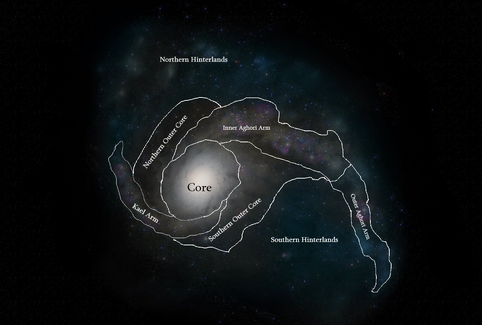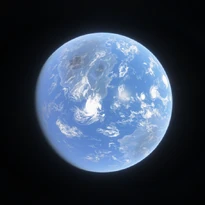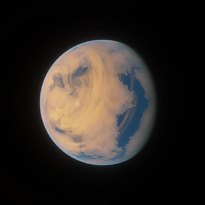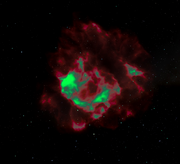The Nyrin Galaxy is a small, low metallicity spiral galaxy, and is the smallest spiral galaxy in the universe. Being the closest satellite of the Florathel Galaxy, the Nyrin Galaxy has recently been under a lot of tidal forces, which has deformed it to the point that one of its two distinct arms has been nearly erased into the galaxy. As a result, star formation is rampant throughout the galaxy.
Being a relatively low metallicity galaxy has kept Nyrin from developing many civilisations in the past, and any civilisations that arose would be able to take control of the entire galaxy without many obstacles. However, a recent surge of star formation (not enough to quickly exhaust the galaxy's gas supply though) has seeded the galaxy with many heavy elements, which has allowed a lot of lifeforms to develop.
Galactic structure
The Nyrin Galaxy has two spiral arms, known as the Kael Arm and the Aghori Arm. The Kael Arm is distinctively smaller than the Aghori Arm. Along with the Core, most of the mass in the galaxy is concentrated in these 3 areas. However, a significant amount of mass can also be found in the Hinterlands, far away from the spiral arms. Here too, star formation is happening, and many new civilisations are popping up.
The Nyrin Galaxy contains 813 million stars, relatively little for a galaxy of its size. At the centre of the galaxy there is a supermassive black hole, known as Eyerin, with a mass of 2.51 million solar masses.
Core
The Core contains some of the oldest stars in Nyrin, and is the oldest part of the galaxy. The large amount of cool, dying stars gives the Core a yellowish tinge. However, recently, an extreme burst of star formation happened in the centre of the Core, near Eyerin, which has resulted in many massive clusters, brightening the Core overall and whitening it.
Kael Arm
The smaller of the two arms, the Kael Arm has severely shrunk since Nyrin entered a close orbit around the Florathel Galaxy. As a result, star formation rates are unsustainable and the highest in any region of the galaxy, but for some reason, there are not many large nebulae visible from outside. The Kael Arm is quite inhospitable due to the sheer amount of star formation.
Aghori Arm
The larger of the two arms, the Aghori Arm has a stable, albeit high rate of star formation. Many large nebulae are visible from outside, especially in the inner part of the arm. Life is more common here than in most of the galaxy, with rates comparable to those found in other galaxies. As the People's Union of Kuruva's power has waned, many nascent civilisations are arising, but there is limited space.

A map of the Nyrin Galaxy
Hinterlands
The outer reaches of the galaxy. The Hinterlands are the result of an older wave of star formation, and there are many evolved massive stars in the region, giving it a distinct blue sheen. This region is actually quite quaint, as star formation is slowing down to a more sustainable level. A few civilisations are developing in these far off regions.
Distribution of structures
Up until the last billion years, the only large-scale structures in the galaxy were 3 globular clusters floating around the galaxy, along with the Kuruva Cluster, and the central cluster.
When Nyrin approached the Flower galaxy, the tidal forces kickstarted star formation again, which allowed more large structures to exist, such as nebulae and clusters. The new influx of stars meant more chances of habitable planets, as well as more luminous massive stars to illuminate the skies of those planets.
Clusters, massive stars and H II regions
Until the last billion years, only 5 star clusters existed within the galaxy, 3 of which were globular clusters, one of which was the Kuruva Cluster, and the other one was the one surrounding Eyerin. As star formation restarted, the number of star clusters rapidly increased. As did the amount of H II regions (housing young massive stars), whereas 1 billion years ago, none existed within the galaxy. The nebulae and clusters are currently most concentrated in the inner Aghori Arm, making many worlds in the section of the galaxy popular tourist destinations. The same can be said for massive stars, which did not exist in the galaxy for about 10 billion years, until the last billion years, when their numbers increased dramatically. Currently, Nyrin houses a healthy (not too large) population of massive and luminous stars, including 46 known Wolf-Rayet stars.
Habitable planets
Because there has not been any star formation until 1 billion years ago, many of the stars which formed in the initial burst of star formation 13-12 billion years ago have died, including all the stars whose masses are above 1 solar masses. Many of the stars whose masses are above 0.8 solar masses have left the main sequence, and most stars from the new wave of star formation are too young to develop habitable worlds, although some have. Therefore, this leaves predominantly old, low-mass stars as the stars for potential habitable planets, and because these systems are so old, they have had many chances to be disrupted by every possible cataclysm.
These factors, compounded by Nyrin's very low metallicity (therefore making it harder to form habitable planets) means that there has historically been very few habitable planets in the galaxy, and so little chances for civilisations to arise. Ripal is a rare example of a planet being habitable enough for it to develop a civilisation, and it orbits a late-K dwarf. In fact, until the last few hundred million years, it was the only civilisation that really stood the test of time by surviving for millions of years, which was possible due to Nyrin's extremely slow pace of life at that time. After the galaxy's rejuvenation, the possibility of widespread habitable planets was a reality again. Over the last 400 million years, many civilisations have sprung up on new habitable planets, which are becoming more and more common every era.
History
Formation Era (13.462 - 12 Gyr BCE)
The Nyrin Galaxy forms, in a far-off corner of the universe. At the time, star formation rates were extremely high, unrecognisable from today, and the metallicity of the universe was so low that life as we know it couldn't possibly exist. At that time, it was an amorphous blob of gas and stars, and it wouldn't be until after the end of the era that the galaxy's characteristic spiral arms appear. Nyrin's central black hole, Eyerin, was an extremely luminous quasar, and started to stop star formation by heating up previously cold gas, which would make it impossible to form stars. The many incredibly luminous stars in the galaxy had the same effect on star formation.
Reformation Era (12 - 10.1 Gyr BCE)
The Galaxy takes shape, and several arms begin to form. Star formation slows down rapidly due to Eyerin, grinding to a near complete halt, and over time, the spiral arms merge into two opposite arms.
Quiet Era (10.1 - 2.81 Gyr BCE)
Not much happens during this era. Star formation slowly dies out, and by the 8 Gyr BCE mark, its effects on the galaxy become negligible. The galaxy takes on a deep yellow hue, filled with dying stars and stellar remnants. Sometimes there is the occasional civilisation here and there, but there are so little opportunities for life to arise that any effects of civilisations on the galaxy are barely noticeable. The galaxy slowly dims, as it wanders around the universe, barely noticeable against the background radiation of the Universe.
PUK Era (2.81 - 0.78 Gyr BCE)
This is when the People's Union of Kuruva, a "socialist democracy" started to spread across the Nyrin Galaxy. At its time, there were no other civilisations in the galaxy, and the PUK expanded across the galaxy with relative ease, despite being slow compared to other civilisations. By the 2 Gyr BCE mark, the PUK controlled all of the inner Aghori Arm (where it originated), most of the outer Aghori Arm, all of the Core, most of the Kael Arm and most of the Outer Core. Over time, it got more and more control of its citizens, to the point where they were literally being mind controlled by the PUK, which ruled nearly all of the Nyrin Galaxy with unparalleled stability and without interference.
However, slowly, as the Nyrin Galaxy approached the Flower subcluster, star formation restarted, initially very slowly. However, it was soon clear that the galaxy would enter a close orbit around the Florathel Galaxy. The PUK didn't think that many consequences would arise from this. However, they were far from the truth. As star formation ramped up, the higher metallicity environment slowly allowed for more life to exist, and the many explosions produced by dying massive stars disrupted the PUK's relatively weak infrastructure.
Revitalisation Era (780 - 558 Myr BCE)
As the Nyrin Galaxy approached the Florathel Galaxy, tidal forces exerted by the Florathel Galaxy along with its large satellites reignited star formation. For the first time in 10 billion years, bright blue massive stars came into being again, lighting up the almost invisible galaxy up from inside. As the metallicity in the galaxy's environment started to increase for the first time, opportunities for life to get started became more and more common as Nyrin approached the Florathel Galaxy. Along with this, the deaths of the massive stars posed problems for the PUK's weak infrastructure, as the PUK never had to deal with the problem of supernovae, and as a result, some of the PUK infrastructure was heavily damaged by supernovae, especially in the two arms.
Instability Era (558-393 Myr BCE)
558 million years ago, a particularly bright supernova caused by a dying Wolf-Rayet star damaged a peacekeeper (a megastructure used by the PUK to keep its citizens in control) nearby, causing several trillion PUK subjects' minds to be freed. They found themselves in a world of oppression, and did not think in the slightest that it was right or that they wanted to stay in it. However, the PUK immediately got notified of this and sent several armies to kill them before things got out of hand. Although the vast majority of them got massacred, a few dozen subjects escaped the planet they were on. When they reached space, they saw the carnage that had happened, and realised the huge opportunities that arose to free all the beings from the PUK. This would be the beginnings of the Northern Revolution and eventually the Republic of Kembar.
As star formation became ever more common, many events like this happened, especially in the vicinity of the first event. As it started to lose more and more control of its citizens, the PUK did not know how to respond to this. Some people wanted to reinforce the PUK's feeble defences, but others feared this would put a total end to control of the PUK's subjects, and in the end, nothing happened. As a result, the PUK lost control of most of the Kael Arm, and nearly all of the Northern Hinterlands.
First Civilisation Era (393-129 Myr BCE)
393 million years ago, the first of many new civilisations resulting from the increased opportunities for life sprung up, in the Southern Hinterlands. It found itself alone, except for the PUK, but it was too busy trying to ward off the consequences of star formation rates it was never meant to handle. Over the next hundred million years, several other civilisations would spring up in various parts of the galaxy, a couple even in the PUK's territory, which made it even less stable. It was clear that the PUK's days were numbered, but it still had some time left.
Kael Arm Exodus
About 129 million years ago, millions of years of extreme star formation in the Kael Arm led to what is now known as the Kael Arm Exodus, in which about 170,000 massive stars exploded in a span of 240,000 years, destroying a lot of PUK infrastructure in the area and practically wiping out its presence in the arm. The event also indirectly freed the minds of quadrillions of individuals by destroying many peacekeepers across the arm. This left many stellar remnants in the arm, as well as very many X-ray binaries, bathing the arm in radiation and making it harder to recolonise, which the PUK tried, but it was only able to recapture a bit of the arm.
Second Civilisation Era (129-35 Myr BCE)
Even more civilisations arised during this period, big and small. Nyrin's political scene became quite similar to that of many other galaxies. None of the civilisations which existed during that time (except the PUK) are still around today, and towards the end of this period, many conflicts had broken out between the different nations. Many perished, and damage of celestial proportions is still visible today.
Nyrin Wipeout
As the PUK became more involved in the conflicts, it decided to try to stop all the wars by demolishing all the states involved, in an event known as the Nyrin Wipeout, which occurred approximately 35.2 million years ago. Not very much is known, but what has been disclosed by PUK officials or PUK defectors, along with external observations indicates the use of things such as artificial gamma-ray bursts, artificial supernovae (both type I and II), and other stellar-related weapons of mass destruction.
Decay Era (35-3.6 Myr BCE)
After the Nyrin Wipeout, the PUK was the only major nation left in the galaxy, and the remnants of the other nations were left alone, and some new nations emerged, but not much else happened. The PUK slowly regained some territory, but all changed when the Telusians entered the galaxy after they explored the Florathel Galaxy for a bit. The remnants were rocked with civil war and anarchy, but nothing was done about it, and over time, they either stopped existing or settled into new nations. The PUK was also making sure that it would be able to defend itself if any invaders tried to take its territory.
Telusian Era (3.6-3.2 Myr BCE)
Around 3.6 million years ago, the first Telusian settlers visited the Nyrin Galaxy, and were quite astonished at what they saw. The galaxy seemed like a good place to settle in, and they slowly advanced through the galaxy. However, the exploration of the galaxy did not receive much funding, definitely not as much as in the Florathel Galaxy. As a result, when some of the Telusians encountered the PUK and tried to rid it from the galaxy, they were quickly erased off the galaxy in a short 2-year conflict known as the Nyrin Telusian Decimation, where about 10% of Telusians (the ones who wanted the PUK gone) were quickly killed. The rest of the Telusian settlers stayed in the galaxy for another 400000 years. Due to insufficient funds and Nyrin not being the most resource-rich galaxy, most of the Telusian settlers left for their home galaxy, or the Florathel Galaxy. However, some of them stayed, becoming self-reliant and splitting away from their parent empire in the process and creating the Nyrin Telusian Commune, a relatively large nation in the Northern Hinterlands.
Current Era (3.2 Myr BCE - Present day)
This is the period of time where the nations currently in the galaxy form, and the astropolitical scene slowly shifts into the one that we are familar with today. This period has been regarded as one of relative peace. There have been some small conflicts here and there, but nothing on the scale of the wars and conflicts in the past.
Future
The future of Nyrin is very uncertain, at least the astropolitical scene. While it is certain that the PUK's days are numbered, nobody is certain of when exactly it will fall. The disappearance of such a huge nation will certainly create an enormous power vacuum in the centre of the galaxy, and what happens next, let alone what will fill the gap is almost unknown. There are many many possible scenarios suggested by many respectable people all over the subcluster as to what may happen, but the general consensus seems to be that several new nations will probably form out of the remains of the PUK. This will definitely have happened by 5 million years in the fuutre.
The future of Nyrin as a galaxy is much less undetermined. It is almost certain that the galaxy will follow a fate very similar to that of Ouranir, where its spiral structure is destroyed by the tidal forces of Florathel, and then huge bursts of star formation occur. The outer stars will be stripped off the galaxy into a stream circling Florathel, and the galaxy will slowly shrink as it shrivels up into an elliptical galaxy and be torn apart by Florathel and eventually be incorporated in its structure. Life will become rarer and rarer in the stellar streams that once were Nyrin, and one day, in the next few billion years, it will become impossible again. Nyrin, now incorporated into Florathel, will slowly darken over the next few trillion years, and soon all which will be left are the remnants of dead stars, slowly circling the central black hole.
Incredibly Far Future
After about a decillion years, even these remnants will be erased off by proton decay, and there will be nothing left of the galaxy, except photons, subatomic particles and black holes. Nyrin will be but a part of Florathel, in this time merely a huge system of black holes, orbiting the central black hole, but even this doesn't last forever. Hawking radiation will take its toll on the black holes, reducing them all to mere particles of light, all alone in the huge universe. In a googol years, Florathel's central black hole now completely alone, will finally explode, and after that, nothing recognisable will be left of the once rich galaxy.
Timeline
Key
Anything in bold is considered to be a major event.
BCE - Before Common Era
CE - Common Era
Before Common Era
| 13,550,000,000 BCE: | - Eyerin forms, in a distant part of the very young universe. |
|---|---|
| 13,462,000,000 BCE: | - The Nyrin Galaxy forms. |
| 13,390,000,000 BCE: | - Eyerin becomes an AGN and quasar, stifling star formation in the galaxy. |
| 12,200,000,000 BCE: | - Eyerin calms down. |
| 12,150,000,000 BCE: | - Nyrin's spiral arms start to appear. |
| 11,880,000,000 BCE: | - The Kuruva Cluster forms. |
| 10,500,000,000 BCE: | - There are no more H II regions larger than 100 light years in diameter. |
| 9,200,000,000 BCE: | - The Remiad System forms in the Kuruva Cluster. (± 20 million years)
- The last O-type star in the primordial Nyrin dies. |
| 8,830,000,000 BCE: | - The Vigimir System forms. |
| 8,000,000,000 BCE: | - The effects of star formation on the galaxy becomes negligible. |
| 7,000,000,000 BCE: | - The Kuruva Cluster is the only place in the galaxy capable of forming stars.
- A civilisation exists in the Northern Hinterlands for about 1,500 years. |
| 6,400,000,000 BCE: | - The population of B-type stars falls to 0 for the first time. |
| 5,490,000,000 BCE: | - Life arises on Ripal. |
| 2,810,670,000 BCE: | - Intelligent life arises on Ripal. |
| 2,810,031,000 BCE: | - Society is founded on Ripal, which achieves space travel soon after. |
| 2,810,000,000 BCE: | - The People's Union of Kuruva is founded after a large proletariat revolution. |
| 2,806,000,000 BCE: | - The PUK controls the entire Kuruva Cluster. |
| 2,751,400,000 BCE: | - The PUK discovers FTL travel and communication.
- The first peacekeeper is constructed, around a red giant star in the Kuruva Cluster, which was stabilised. |
| 2,558,000,000 BCE: | - The PUK reaches Eyerin. |
| 2,380,000,000 BCE: | - The PUK controls the entire inner Aghori Arm. |
| 1,800,000,000 BCE: | - Nyrin starts to drift towards the Florathel Subcluster. |
| 1,040,000,000 BCE: | - An O-type star forms, for the first time in 8 billion years. |
| 920,000,000 BCE: | - Nyrin becomes the closest galaxy to Flower for some time. |
| 675,000,000 BCE: | - A large H II region is created for the first time in about 10 billion years. |
| 558,000,0000 BCE: | - The first peacekeeper destruction event occurs, seeding the beginnings of the Republic of Kembar. |
| 511,640,000 BCE: | - The Northern Revolution begins. |
| 511,151,000 BCE: | - The Northern Revolution ends with the creation of the Republic of Kembar. |
| 393,000,000 BCE: | - The first civilisation resulting from the metallicity increase is born. |
| 129,000,000 BCE: | - The Kael Arm Exodus occurs, forcing the PUK to leave the area. |
| 85,600,000 BCE: | - The Blossom Nebula forms around the Kuruva Cluster. |
| 35,210,000 BCE: | - The PUK exterminates nearly every nation in the galaxy, bringing an end to millions of years of war. |
| 3,600,000 BCE: | - Telusians enter the galaxy, in search of resources and controlling the galaxy. |
| 3,586,000 BCE: | - The Nyrin Telusian Decimation occurs. |
| 3,200,000 BCE: | - Most Telusian settlers leave the galaxy. |
| 3,070,000 BCE: | - The Intergalactic Telusian Commune is created on Mirin. |
| 97,489 CE: | - The Tears of Vigimir forms. |
Celestial bodies and systems
Major Worlds
 |
 |
 | |
|---|---|---|---|
| Location | |||
| Population | 141 billion | 88 billion | |
| Unique Attributes: | Very secretive |
 | |
|---|---|
| Location | |
| Population | 50.5 billion |
| Unique Attributes: | Near a protoplanetary nebula |
Notable/Major stars/star-like bodies
- Eyerin - Eyerin is the central black hole of the galaxy. Eyerin currently has one of the smallest black hole accretion disks of any supermassive black hole. In the past, the disk was larger, but when the PUK arrived, it used much of the accretion disk and surrounding material to build a large peacekeeper, which controls the populations around the black hole and in the inner core. Only 11 stars are known to orbit Eyerin with separations under 1 light year, most of which are white dwarfs or neutron stars.
Notable/Major clusters and nebulae
- Kuruva Cluster - A giant open cluster, containing aging, low-mass stars as well as young, bright high-mass stars. The Kuruva Cluster was the only surviving open cluster after the end of star formation in the Nyrin Galaxy, about 12 billion years ago. It is the origin of the People's Union of Kuruva, currently the most powerful nation in the galaxy, but that may soon change.
- Blossom Nebula - Being a starburst galaxy, Nyrin will be in abundance of large nebulae, such as the Blossom Nebula. Located in the inner Aghori Arm, this nebula the largest and brightest. It is especially significant as it houses the Kuruva Cluster, one of the most important structures in Nyrin and the home of the People's Union of Kuruva, as well as being home to 7 Wolf-Rayet stars, 2 luminous blue variables, 2 yellow hypergiants, and countless other bright, hot stars, most of which are sadly obscured by a lot of dust, typical of giant nebulae like this one.
- The Tears of Vigimir - This is a very young protoplanetary nebula surrounding the RV Tauri variable, Vigimir. The protoplanetary nebula was once thought to threaten the existence of one of the most important planets in the Nyrin Galaxy, Meitura, because Meitura's parent star, Sepitome, is located in a binary with Vigimir, but further studies concluded that the nebula is completely harmless, and it is being mined extensively by several megacorporations in the Meithar Union. The nebula appears in Meitura's sky as a faint blue patch surrounded by red arcs, and is about 2500 years old.
Notable Anomalies
The Nyrin Galaxy is home to several exceptionally strange phenomena, as well as some general anomalies found in some other galaxies as well. Some of these anomalies have only been documented in Nyrin, due to the galaxy spending much of its time alone.
Wormholes
Nyrin holds a relatively high concentration of wormholes, but not as much as some other galaxies, like Florathel. About 14,000 wormholes have been documented in the galaxy so far, most of which reside in the core and inner arms. Most of these wormholes lead to other places in the galaxy, although some will lead to other galaxies, or in some unfortunate cases, intergalactic space.

Muonium Nebulae
Muonium nebulae are emission nebulae (H II regions) in the Nyrin Galaxy that contain incredibly large quantities of muonium (atoms where electrons are replaced by muons), in some, quantities as high as 1 muonium atom per every 30 atoms. Muonium atoms are slightly heavier than their normal counterparts, and could cause some weird effects when they are mixed in the ISM. Ionised muonic hydrogen looks rather different to regular hydrogen, changing colour quickly as it gets hotter, a property unique to itself. Therefore, some muonium nebulae look very funky, containing many different colours.
Nyrin is the only galaxy where muonium can exist for long periods of time, and it is unknown why this is. Where the muonium originally comes from is also not very much known, but it is likely related in some way to Eyerin.
Muonium Stars
Muonium stars are stars which are composed of a significant percentage of muonium, usually muonic hydrogen. They are much more subtle anomalies than muonium nebulae, as the muonium doesn't change their appearance much, if at all. Most of the time they look the same as regular stars, but the stars with the most muonium may look slightly more saturated than their normal counterparts. The added mass in a muonium atom compared to a hydrogen atom will mean that a muonium star with a certain amount of atoms will be slightly heavier than a regular star with the same amount of atoms.
Muonium concentrations in these stars are quite low, and the criteria for muonium star classification states that the concentration of muonium in these stars must be between 100 times the concentration in the galaxy's interstellar medium, and up to 10% of the star. Only about 20,000 muonium stars have been catalogued in the galaxy.
